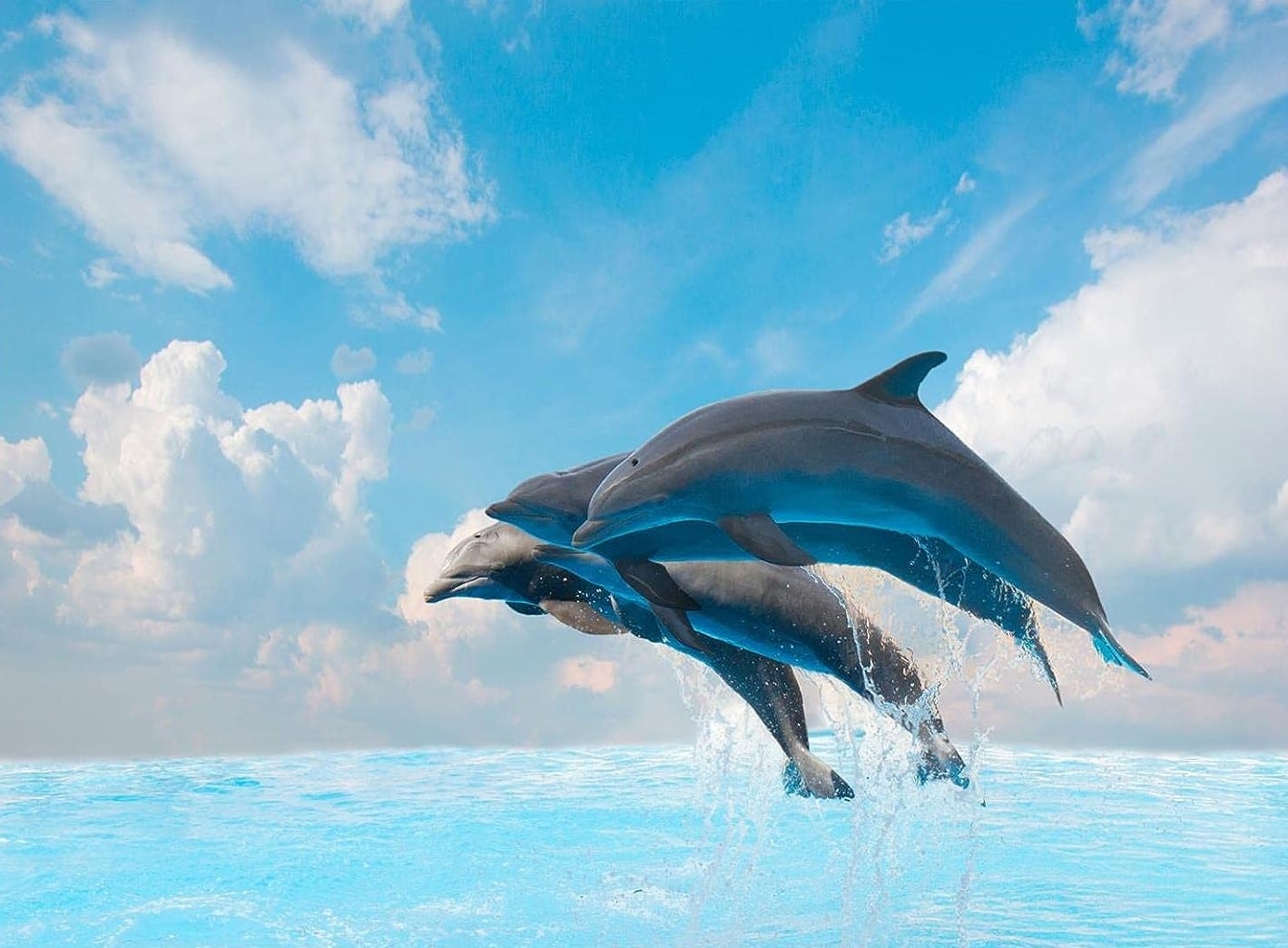Why Do Dolphins Jump Out Of Water

Introduction
The oceans, vast and enigmatic, have always captivated the human imagination. Beneath their azure depths, a world of incredible creatures exists, each with unique behaviors and mysteries. Among these captivating inhabitants, the dolphin stands out as one of the most charismatic and intelligent species, known for its dazzling displays of acrobatics, particularly its spectacular leaps out of the water. But why do dolphins jump out of water? What drives these remarkable creatures to break through the ocean’s surface and soar into the air?
In this exploration, we delve into the intriguing phenomenon of dolphin leaps, unraveling the fascinating reasons behind their aerial displays. As we journey into the depths of the ocean and the depths of scientific inquiry, we seek to uncover the secrets that lie behind this extraordinary behavior, shedding light on the mysterious world of these aquatic marvels.

Why do dolphins jump from the water?
Dolphins are renowned for their breathtaking aerial displays, leaping out of the water in a collection of agility and grace. While the exact reasons behind this behavior are not definitively understood, scientists have proposed several theories to explain why dolphins engage in this captivating behavior.
Communication: One widely accepted theory suggests that breaching, as the act of leaping out of the water is called, may serve as a form of communication among dolphins. These magnificent leaps create a distinctive and attention-grabbing sound when the dolphin re-enters the water, generating a splash and a distinct acoustic signal. This could be a way for dolphins to convey messages, signal their presence, or coordinate group movements. It’s like a spectacular form of “flipping the lights on” to get everyone’s attention.
Predator Avoidance: Dolphins have numerous natural predators, including sharks and larger marine mammals. Jumping out of the water may be a strategy to evade potential threats from below. By briefly leaving the water’s surface, dolphins can quickly assess their surroundings, spot predators, and rapidly escape if necessary.
Social Bonding: Breaching could also reinforce social bonds within dolphin pods. These creatures are highly social and intelligent, and engaging in playful or synchronized leaps may strengthen group cohesion and communication. Such coordinated activities are often seen among dolphins, fostering unity within the pod.
Ridding of Parasites: Another intriguing hypothesis is that breaching may help dolphins rid themselves of parasites or irritating organisms attached to their skin. The forceful impact of the water may dislodge these unwanted hitchhikers, ensuring the dolphin’s health and comfort.
Display of Vitality: In some instances, breaching might be a display of physical prowess and vitality. This behavior could signal to potential mates that the dolphin is healthy, strong, and a suitable partner for reproduction.
Playfulness: Dolphins are known for their playful nature, and breaching could express joy and vitality. Just as humans engage in recreational activities for fun, dolphins might leap out of the water because it pleases them.
While these theories offer valuable insights into why dolphin jumps from the water, it’s essential to remember that these intelligent creatures are complex. A combination of factors may drive their behavior. Further research and observation are needed to unravel the full extent of the motivations behind this mesmerizing behavior, adding to our understanding of these remarkable marine mammals.
Why do dolphins jump out of the water and spin?
Dolphins are renowned for their incredible acrobatics, often jumping out of the water and spinning in the air. While the exact reasons for these behaviors are unknown, scientists have proposed several theories to explain why dolphins engage in these mesmerizing aerial displays.
Communication and Signaling: One theory suggests that jumping and spinning serve as a form of communication among dolphins. These elaborate displays create distinct splashes and sounds upon reentry, which could be used to convey messages to other dolphins. Such signals might help coordinate group movements, alert others to the presence of food or predators, or even express excitement or happiness within the pod.
Playfulness and Social Bonding: Dolphins are known for their playful nature, and leaping and spinning could be a way for them to have fun. Engaging in these acrobatics might strengthen social bonds within the pod, as dolphins often play together and synchronize their movements, fostering a sense of camaraderie and shared experiences.
Hunting Strategy: Some scientists believe these aerial displays could be part of a hunting strategy. Dolphins might get a better vantage point above the water’s surface by jumping and spinning, allowing them to spot schools of fish or potential prey more easily. This behavior could be an integral part of their cooperative hunting tactics.
Predator Evasion: Just like the theory for breaching alone, jumping and spinning could be a way for dolphins to evade potential predators. The rapid movements and high jumps could confuse or deter would-be attackers, allowing the dolphins to escape safely.
Exercise and Energy Release: Dolphins are highly active animals, and these acrobatic displays may serve as a form of exercise and energy release. Jumping and spinning require significant physical effort and may help dolphins stay in peak physical condition.
Mating Displays: In some cases, these displays could be a way for dolphins to attract potential mates. Demonstrating agility, strength, and vitality through impressive leaps and spins may be a means of showcasing their desirability as a mate.
Why do dolphins come to the surface?
As marine mammals, Dolphins have evolved various adaptations to life in the water, and coming to the surface serves several crucial purposes in their daily lives. Here are some primary reasons why dolphins come to the surface:
Breathing: Dolphins are air-breathing animals, which means they must regularly come to the surface to breathe. Unlike fish, which extract oxygen from water through gills, dolphins rely on lungs to obtain oxygen. Blowholes are on the tops of their heads, allowing them to quickly and efficiently take in air when they surface. Dolphins are conscious breathers, so they must actively consider coming up for air. They typically arise every few minutes, although the exact frequency can vary depending on the species and activity level.
Communication: Dolphins are highly social animals and use a variety of vocalizations to communicate with each other. When they come to the surface, they often make characteristic clicks, whistles, and different sounds that can be heard above and below the water. This surface communication is vital for coordinating group activities such as hunting and maintaining social bonds within a pod.
Orientation and Navigation: Dolphins use their eyesight above and below the water’s surface. Coming to the surface allows them to assess their surroundings visually, look for potential prey, predators, or other pod members, and navigate their aquatic environment more effectively.
Thermoregulation: Dolphins have a thick layer of fat under their skin, which helps insulate them in cold ocean waters. However, overheating can also be a concern, especially when they are active. By coming to the surface, dolphins can dissipate excess body heat through their skin, helping to regulate their body temperature.
Rest and Sleep: Dolphins are known to rest and sleep, but unlike humans, who sleep in long, uninterrupted periods, they sleep with one hemisphere of their brain at a time. This allows them to continue swimming and breathing while getting the needed rest. Coming to the surface is essential during these resting periods to ensure they can live and remain alert to potential threats.
Feeding: When hunting for fish and other prey, dolphins often approach from below and use their sharp eyesight to track and catch their quarry. Coming to the surface allows them to assess the location of prey and execute precise strikes quickly.
What is the word for dolphin jumping out of water?
The term used to describe the captivating and often breathtaking act of a dolphin leaping out of the water is “breaching.” Breaching is a word that encapsulates the dynamic and graceful movement of dolphins as they propel themselves out of the ocean’s surface, defying gravity for a brief moment before splashing back into the sea. This behavior is a remarkable spectacle, often accompanied by joyful flips, spins, or twists, showcasing the agility and power of these magnificent marine creatures.
Dolphin breaching is not only a visual spectacle but also an auditory one, as it generates distinctive sounds when the dolphin reenters the water, creating a splash and a reverberating echo that can be heard both above and below the surface. Scientists and marine enthusiasts have long been fascinated by this behavior, which remains a study and admiration subject.
Breaching serves various purposes for dolphins, including communication, playfulness, hunting, and escaping potential threats. Regardless of the specific reason, witnessing a dolphin breaching is a remarkable experience, and the term “breaching” aptly captures the essence of this incredible natural phenomenon that continues to inspire wonder and awe in those fortunate enough to witness it.
Are dolphins happy when they jump out of the water?
It’s challenging to definitively determine dolphins’ emotions or subjective experiences, including whether they feel happiness when jumping out of the water. Dolphins are brilliant and social animals; a complex interplay of factors influences their behavior.
When dolphins engage in activities like breaching (jumping out of the water) or performing acrobatics, they may do so for various reasons:
Playfulness: Dolphins are known for their playful nature, and these actions could be a form of play. Play is not necessarily an indicator of happiness in the human sense, but it’s an essential aspect of their cognitive development and social bonding.
Communication: Breaching can be a way for dolphins to communicate with one another. It may serve as a signal or form of interaction within their pod.
Hunting or Predator Evasion: In some cases, breaching may be related to hunting or evading predators. It’s a behavior that can serve practical purposes for their survival.
Exercise: Dolphins are active animals that require physical activity to stay healthy. Breaching and other acrobatic behaviors may provide them with training and stimulation.
While we can’t definitively attribute happiness to dolphins when they breach, it’s clear that these behaviors are part of their natural repertoire, serving a variety of functions. Dolphins can experience a range of emotions, and they are known to form strong social bonds within their pods. Some captive dolphins in marine parks may also be trained to perform tricks for food or rewards, but this does not necessarily indicate their emotional state.
Researchers continue to study dolphin behavior and cognition to understand their experiences and emotions better, but determining happiness in animals remains a complex and challenging endeavor.
Why do dolphins slap the water?
Dolphins, those charismatic marine mammals, engage in various behaviors that are intriguing to observers. One of these behaviors is the act of slapping the water, which, like many aspects of dolphin behavior, serves multiple potential purposes:
Communication: Dolphins are highly social animals and use a variety of vocalizations and physical gestures to communicate with one another. Slapping the water can create a distinct sound that may be used for communication within their pod. It can serve as a way to get the attention of another dolphin, convey messages, or signal group movements.
Playfulness: Dolphins are well-known for their playful nature. Slapping the water can be a form of play, similar to how they engage in leaping, spinning, and chasing each other. Play is essential for their cognitive development and social bonding.
Hunting or Herding Fish: Dolphins are skilled hunters and often work together in coordinated efforts to catch schools of fish. Slapping the water can create vibrations that disorient or corral fish, making it easier for the dolphins to catch their prey. It’s a practical and cooperative hunting strategy.
Stress or Irritation: Slapping the water could sometimes indicate stress or irritation. Captive dolphins, in particular, have been observed engaging in this behavior in unnatural or stressful environments.
Expression of Energy: Dolphins are highly energetic animals, and slapping the water might be a way to release excess energy. It’s akin to humans engaging in physical activities or gestures when excited or stimulated.
Territorial or Defensive Behavior: Sometimes, slapping the water could be a territorial display or a means of defending their territory from intruders or potential threats.
Why do dolphins like humans?
The notion that dolphins like humans is based on anecdotal observations and experiences, often stemming from interactions between humans and captive dolphins in marine parks or encounters with wild dolphins in the open ocean. However, it’s important to clarify that the idea that dolphins are inherently like humans might be somewhat anthropomorphic, attributing human emotions and preferences to these marine mammals.
Dolphins are brilliant and social animals curious about their environment, including humans. Here are some reasons why dolphins may appear to be interested in or friendly toward humans:
Curiosity: Dolphins are known for their interest and exploration of their surroundings. When encountering something new or unfamiliar, such as humans, they may approach out of curiosity to investigate and interact.
Playfulness: Dolphins exhibit playful behavior, both among themselves and with other species, including humans. They may engage in activities like riding the bow waves of boats or playing with objects that humans introduce into the water.
Social Interaction: Dolphins have complex social structures within their pods and may view humans as potential social companions. In some cases, dolphins in captivity or the wild have shown an interest in interacting with humans.
Positive Associations: In captivity, dolphins may associate humans with food, attention, and positive reinforcement due to their training and interaction with trainers. This can lead to dolphins approaching humans hoping to receive rewards or attention.
Natural Curiosity: Dolphins have evolved to be curious animals, and their interest in the world around them extends to various species, including humans. They may approach boats or swimmers simply because they are naturally curious creatures.
It’s important to remember that interactions with wild dolphins should always be respectful and follow guidelines for responsible wildlife viewing to avoid disrupting their natural behaviors or habitats. While dolphins may exhibit friendly or curious behavior towards humans, it does not necessarily indicate a specific liking for humans as individuals.
The perception of dolphins “liking” humans is likely a combination of their natural behaviors, their interactions in captivity, and our human tendency to anthropomorphize animals. Dolphins are incredible creatures deserving of our respect and protection in their natural habitats.

Conclusion
In conclusion, the mesmerizing behavior of dolphins jumping out of the water, known as breaching, continues to captivate our curiosity and imagination. While we may not have all the definitive answers to why dolphins engage in this spectacular display, we have uncovered several compelling theories. Breaching serves as a multi-purpose behavior for these intelligent marine mammals.
It can be a form of communication, a way to bond with their pod members playfully, a strategy for hunting or evading predators, or even an expression of their vitality and energy. These theories remind us of the complexity of dolphin behavior and the depth of their social and cognitive lives.
As we continue to study and observe these remarkable creatures in their natural habitats, we gain a deeper appreciation for the intricacies of their lives beneath the waves. The enigma of why dolphins jump out of the water invites us to explore the depths of the oceans and the depths of scientific inquiry, encouraging us to cherish and protect these magnificent animals and the fragile ecosystems they call home. Ultimately, the mystery of dolphin breaching reminds us of the enduring wonder and awe that the natural world never fails to inspire.



